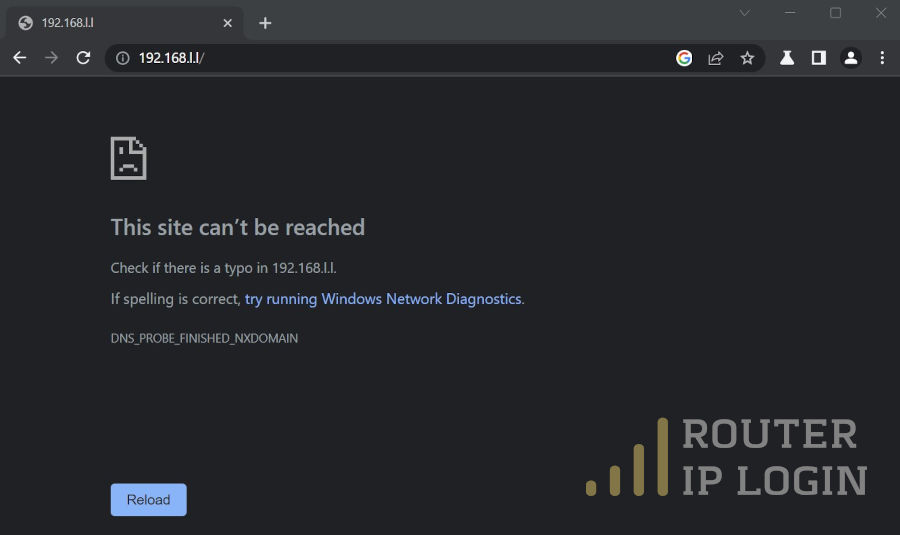192.168.l.l - Admin Login
What is the 192.168.l.l IP
Did you know that the wireless router you have at home has two Internet Protocol (IP) addresses? Your Internet Service Provider (ISP) assigns the public IP. Your router uses it to send and receive data packages to and from websites, apps, and internet services. The other IP, called a private IP, is what the router uses to communicate with the devices within your home or office network. 192.168.l.l is your router’s private IP.
Login at 192.168.l.l
Access your router as Admin
How to Login to your router with IP address 192.168.l.l or 192.168.1.1
The 192.168.l.l IP is the foundation of your wireless network. Among other things, this address gives you direct access to your router’s settings menu. You can improve your wireless network security and speed from there. Tuning up your 192.168.l.l router’s settings doesn’t require particular tech-savvy on your part. The process is simple, and even if you make a mistake, you can always factory reset the device. It will allow you to start afresh without worrying that you might get locked out of your router.
Initial Preparations
The first thing you would want to do is to make sure that your router’s private IP is indeed 192.168.l.l. Some of the most popular brands and models use namely this gateway IP, l like:
- TP-Link
- NEC
- Samsung
- Huawei
Finding Your Private IP Address in Windows 10
Follow these steps to find if your private IP is 192.168.l.l, if you are using a PC or a laptop with a Windows 10 OS:
- Connect the router’s wireless network.
- Use the search bar in the left corner of the taskbar, next to the Windows button.
- Open the Settings app
- Choose Network and Internet
- You will see a “Status” tab in the left pane. Open it and then click on Properties in the right pane.
- The “View your network properties” window will pop up. Your private IP is listed next to IPv4.
If the string of numbers next to IPv4 is 192.168.l.l, then it is indeed the gateway IP that you can use to access your router’s settings.
Finding Your Private IP Address on Mac
Follow these steps to find if your private IP is 192.168.l.l, if you are using an iMac, Mac Mini, MacBook, or another Apple computer:
- Go to the top menu bar and click on the Apple icon.
- From the drop-down menu, select System Preferences.
- Open the Network tab in the window that pops up.
- If you are connected to a wireless network, choose Wi-Fi in the left pane.
- The IPv4 entry shows your private IP.
If the string of numbers next to IPv4 is 192.168.l.l, then it is indeed the gateway IP that you can use to access your router’s settings.
Finding your Private IP on an iPhone
If you are on an iPhone, you can find if your private IP is indeed 192.168.l.l by:
- Going to Settings
- Selecting WiFi
- Tapping on your wireless network’s name
Your private IP will be listed in the IP Address entry in the IPv4 section.
Finding your Private IP on an Android Phone
You can check if your private IP is 192.168.l.l on your Android phone with the following steps:
- Open the Settings menu
- Go to the WiFi section
- Tap on the gear-shaped icon
Your private IP address should be listed in the window that pops up.
Accessing your Wireless Router at 192.168.l.l
Now that you are certain what your private IP is, you can proceed to tune up your wireless network. The best way to do that is by connecting a PC or laptop to the router directly via an Ethernet cable. That will provide you with a stable, uninterrupted connection. If you don’t have an Ethernet cable at hand, you can use a wireless connection to your router. The same goes if you prefer to use a mobile device to access the settings menu. If you choose the latter option, make sure you stand close to the router so that you enjoy a strong, stable wireless connection.
Open an internet browser of your choice, such as:
- Chrome
- Mozilla Firefox
- Opera
- Safari
Go to the address bar and type your private IP 192.168.l.l. Hit Enter, and you
will find yourself on the home page of your wireless router’s settings
page. Here you will be prompted to enter a username and password.
 If it is the
first time you are using the device, you will need to use the default logins
set by the manufacturer. Usually, they are a combination of the following:
If it is the
first time you are using the device, you will need to use the default logins
set by the manufacturer. Usually, they are a combination of the following:
- “user” and “password”
- “admin” and “admin.”
- The model of the router and “0000”
Manufacturers assign the same default logins for all devices of a model they produce. Typically you can find them listed on the label at the back of the router or in the device’s user manual.
The Default Logins Don’t Work
It is possible that you won’t be able to log in to your router at 192.168.l.l with the default username and password. This could happen in two cases:
- You have had your ISP set up your wireless network. In the process, they have changed the default password and username.
- You have bought the router second-hand. The previous owner has changed the login credentials.
One course of action is to try to contact your ISP or the router’s previous owner. They should be able to tell you what username and password to use to log into your 192.169.l.l router. Don’t worry if, for some reason, you can’t do that. You can factory reset your wireless router and regain access to the device’s menu.
To factory reset your 192.168.l.l router, you will need to:
- Make sure the device is switched on.
- Locate the reset button at the back. Note you might need a pin or a paper clip to press and hold the reset button.
- Keep the reset button pressed for at least 20 seconds.
- You will notice the lights at the front of the router blinking. At one point, they will turn off and turn back on.
- Wait for 20 more seconds.
Keep in mind that the process of factory resetting the router will wipe clean any changes to the settings that you or your ISP have made before that. Once you have completed the factory reset, you should be able to log in using the default username and password. Go to 192.168.l.l in your browser and type them in.
Changing Your Wi-Fi Settings
There are a few things that you might want to look into when you log in to your router’s settings at 192.168.l.l. The first order of business will be to change the name of your wireless network. You can do it from the Wi-Fi settings tab.
Here, what matters is whether you use the router at the office or home. Work environments suggest a more conservative, official-sounding name for the Wi-Fi network. The name of your company should be enough. At home, you can be as creative as you wish. The name helps your network stand out from the others within range. It may reflect your personality, tastes, or sense of humor. The three top qualities of a good Wi-Fi network name are:
- It is easy to remember
- It is inoffensive
- It is creative
In the same tab, you can also set up a password for the network. Anyone who wishes to use your internet connection will need it to sign on.
Improve the Security of your 192.168.l.l Router
Manufacturers usually assign the same username, password, and default IP to all routers they release. That makes the devices vulnerable to unauthorized access. If you want to avoid malicious parties from accessing the settings of your router, you might want to change these settings while you are in the 192.168.l.l menu. By doing so, you will add an extra layer of security on your network and, from there – on your data.
To change the default login credentials for your router, go to the Network Settings tab. There, you will be prompted to choose a new username and password. Before you hit save, make sure to remember or write them down. You will need them the next time you try to log into your router’s settings.
The same goes for the private IP address. You can choose a new string of numbers and add them to the IPv4 section in the Network Settings tab. Your router will not allow you to set up a limited range of IP numbers. These are part of the Internet Assigned Numbers Authority (IANA) IPv4 Special-Purpose Address Registry:
- 10.0.0.0/8 IP addresses: 10.0.0.0 – 10.255.255.255
- 172.16.0.0/12 IP addresses: 172.16.0.0 – 172.31.255.255
- 192.168.0.0/16 IP addresses: 192.168.0.0 – 192.168.255.255
Even without those, you still have several billion combinations to choose from at any time. Remember to write down the new private IP you choose for your router. Once you save the change, you will not be able to access your device’s settings at 192.168.l.l unless you factory reset it.
VPN and Internet Security
In addition to 192.168.l.l, your router has another IP address. It is called public IP, and its purpose is to locate your device within the Internet framework. Your ISP assigns your IP. Websites, servers, and apps use the public IP to receive data from your home or office network. They send data packages to it as well. The public IP contains some information about your physical location and other personal info. Internet security experts point out that this can be a potential threat to regular users. Because of this, it is recommended to use VPN services to hide your public IP while browsing the internet. There are many free and paid VPN services out there. The good news is that many modern routers that have a built-in VPN function. If your router has such, you will find it in a separate tab on the settings page at 192.168.l.l.
What Purpose Does a Private IP like 192.168.l.l Serve
The public IP is the PO Box your network uses to send and receive data packages from the internet. In the same fashion, the private IP 192.168.l.l is the gateway for your wireless network. Each device you connect to your Wi-Fi at home or the office finds the router at that address. In return, the phones, laptops, and printers you connect receive their private IPs that are related to the router’s private IP. The router uses these IPs to distribute the data packages it receives from the internet so that you can access your websites, web services, and servers. In theory, you can connect up to 255 different devices to a single router. In practice, the number depends on the hardware capabilities of the device. Low-tier routers support up to 8-10 devices at the same time. High-end routers for home use will provide a fast, stable connection to as many as a couple of dozens of devices.
